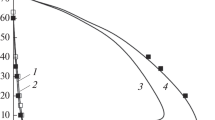Summary
The influence of acetone, methanol andn-propylalcohol, in various concentrations, on the Na-emission and the temperature in an air-acetylene flame has been investigated at various gas/air ratios and at various heights in the flame. A sprayer with spray-chamber and a Meker burner have been used. The experiments indicate that the gain in Na-emission upon adding organics to the analyzed solution cannot be related simply to a single property of the organic-water mixture only. The experiments on the flame temperature, measured by line-reversal, show that spraying organic liquids into the flame may result in an increase or a decrease of flame temperature, according as the gas-air mixture is lean or rich. The effect of these organic liquids on the flame temperature and so on the excitation of Na appears to be small when compared to their effect on the spray-yield. The measured temperature effect appears to agree with quantitative calculations.
Zusammenfassung
Der Einfluß verschiedener Konzentrationen von Aceton, Methanol und n-Propylalkohol auf die Na-Emission und Temperatur einer Acetylen-Luftflamme wurde untersucht, wobei sowohl die Höhe der Meßstelle in der Flamme wie auch das Gas/Luft-Mischungsverhältnis variiert wurden. Ein Indirektzerstäuber und Mekerbrenner wurden dabei benutzt. Die Zunahme der Na-Emission hängt nicht in einfacher Weise von nur einer einzigen Eigenschaft des Lösungsmittels ab. Die Messungen der Flammentemperatur wurden mit Hilfe der Liniemimkehrmethode durchgeführt und zeigten, daß bei Zugabe der organischen Substanzen eine Erhöhung oder eine Erniedrigung der Temperatur auftreten kann, je nachdem, wie gerade das Gas/Luft-Mischungsverhältnis eingestellt wird. Der Einfluß der organischen Lösungsmittel auf die Flammentemperatur und dadurch auf die Anregung der Na-Atome ist gering im Vergleich mit deren Effekt auf die Zerstäuberwirkung. Die gemessene Temperaturbeeinflussung stimmt mit dem berechneten Wert überein.
Résumé
En changeant les mélanges d'acétylène/air et l'hauteur de la région mesurée dans la flamme, on a étudié l'influence des différentes concentrations d'acétone, méthanol et n-propylalcool sur la température de la flamme et sur l'émission du Na. Un pulvérisateur indirect et un brûleur de Meker ont été utilisés. Les expériences montrent que l'accroissement de l'émission du Na, causé par la substance organique, n'est pas liée simplement à une seule propriété de la mélange organo-aqueuse. En mesurants la température de la flamme par la méthode d'inversement de raye nous avons montré que l'addition de substance organique donne aussi un accroissement, qu'un abaissement de la température, selon que la mélange gaz/air est faible ou riche. L'effet de la substance organique sur la température (et par la sur l'excitation du Na) se montre plus faible que l'effet sur le rendement du pulvérisateur. L'effet sur la température mesuré est en concordance avec l'effet calculé.
Similar content being viewed by others
Literature
G. W. Curtis, H. E. Knauer, andL. E. Hunter, A. S. T. M. Symposium on Flame Photometry, Techn. Publ.116, 67 (1951).
J. Smit, C. Th. J. Alkemade, andJ. C. M. Versohure, Biochim. Biophys. Acta6, 508 (1951).
G. R. Kingsley andR. R. Schaffert, Science116, 359 (1952).
R. D. Caton andR. W. Bremner, Analyt. Chemistry26, 805 (1954).
B. E. Bernstein, South African J. Med. Sci.20, 57 (1955).
E. Pungor, A. J. Hegedüs, I. Konkoly Thege, andE. É. Zapp, Mikrochim. Acta [Wien]1956, 1247.
D. Exley andD. Sproat, J. Sci. Instruments85, 202 (1958).
D. D. Vukanovic, Bull, instit. nucl. sci., Belgrad8, 43 (1958).
J. Perman, Colloquium Spectroscopicum Internationale VIII., Luzern, 1959.
C. Th. J. Alkemade, Thesis, Utrecht 1954.
C. Th. J. Alkemade, Colloquium Spectroscopicum Internationale VIII., Luzern, 1959.
Handbook of Chemistry and Physics, 1953.
E. Justi, Spezifische Wärme, Enthalpie, Entropie und Dissoziation technischer Gase. Berlin: J. Springer. 1938.
A. F. Gaydon andH.G. Wolfhard, Flames. London: Chapman & Hall. 1953.
H. Zettler, Thesis, Frankfurt a. M. 1953.
Author information
Authors and Affiliations
Additional information
On leave from Israel Atomic Energy Commission Hakyria, Tel Aviv.
Rights and permissions
About this article
Cite this article
Avni, R., Alkemade, C.T.J. The rôle of some organic solvents in flame photometry. Mikrochim Acta 48, 460–471 (1960). https://doi.org/10.1007/BF01218987
Received:
Issue Date:
DOI: https://doi.org/10.1007/BF01218987




